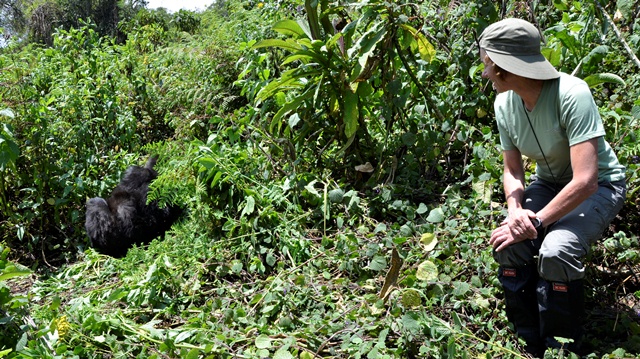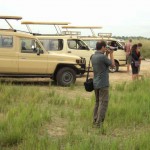
| Virungas1989 | Virungas 2003 | Bwindi 2002 | Bwindi 2006 | |
| Number of Habituated | 189 | 269 | 72 | 76 |
| Number of Unhabituated | 114 | 80 | 248 | 249 – 264 |
| Pecentage of Habituated | 58% | 71% | 23% | 22.4 – 23.4% |
| Estimated | 324 | 380 | 320 | 325-340 |
In the Virungas, between 1989 and 2003:
– 3 additional groups were habituated and opened up for gorilla trekking in Uganda.
– 6 habituated groups fissioned (creating ‘new’ habituated groups)
– 5 habituated groups disintegrated or disappeared
In the Virungas: 3 gorilla research groups, 13 gorilla tourist groups In Bwindi: 1 research group, 4 tourist groups
Only 23% of gorilla population in Bwindi is habituated while 71 % of gorilla population in the Virungas is habituated.
5.0 Recommended Visitor Group Size for Mt. Gorillas
| Gorilla Gp. Size | Risk of disease | Tourism activity? | Recommended |
| spread to the POpIl. | total visitors | ||
| 0-5 | Small | Not | No tourists |
| 6-15 | Medium | Acceptable Risk | Up to 10 visitors |
| 16+ | High | Not | No tourists |
| recommended |
Source, Homsly 1999
According to Homsly 1999, there should be no visits for gorilla groups smaller than 6 or larger than 15 animals, no more than 10 people per tourist group.
Mountain Gorilla Census – Bwindi Impenetrable National Park 2006 – Summary Report
Periodic censuses of endangered populations of high-profile species help us to understand their population dynamics, to assess the success of conservation programmes aimed at ensuring their survival, and to ensure that they received continued attention from the global conservation community. Mountain gorillas Gorilla beringei beringei are highly endangered, with just two small populations in Bwindi Impenetrable forest in SW Uganda, and the nearby Virunga Volcanoes on the borders with Rwanda and the Democratic Republic of Uganda. A survey of the Bwindi population was carried out in 2002, and results showed that the population had increased since the previous census in 1997 by approximately 7 %, to 320 individuals. A new census of the Bwindi gorilla population was carried out between April and June 2006 to determine the total population size and structure for the Bwindi mountain gorillas, their distribution across Bwindi and the potential impact of human disturbance on the population. This now provides us with park-wide information spanning 9 years.
To estimate the total population size for the gorillas, the forest is intensively surveyed by teams with the goal to locate every gorilla group of the population. This method normally allows us to ensure that groups are not counted twice by different teams. However, during the census, several gorilla groups were found in close proximity to each other in one area of forest, such that we were unable to distinguish each on the basis of trails and nest counts alone. In previous census we have generally been able to distinguish groups on the basis of trails and nest sites, but were unlucky this time in having so many groups in a relatively small area of forest.
Therefore to ascertain that we were not double-counting groups, and to ensure that we were able to distinguish and identify each group, we used genetic analysis of fecal samples to create genotypes, or unique genetic identifications, of the gorillas in each group. Fecal samples of all groups were collected for genetic analysis, and this work was carried out at the Max Planck Institute for Evolutionary Anthropology in Leipzig, Germany. Individuals from the groups for which identifications were not clear from the field data on nest sites and trails were treated as priorities. DNA analysis for these has now been completed, allowing us to calculate a final total and other population parameters from this census.
Methods
The census used the same methods as previous exercises. The park was divided into small sectors, centered around campsites and access points. Teams of trackers, rangers, and researchers traversed the park systematically sector by sector. One team was assigned to census each sector, proceeding such that no more than 3 days were left between the completion of work in one sector and the beginning of work in the next contiguous sector. Each sector was searched by walking an irregular network of reconnaissance routes across the area. The actual route walked was determined largely by the terrain and the availability of existing trails, while ensuring that the routes were sufficiently dense so that no area was missed which could be large enough for a gorilla group to spend more than one week in it. Gorillas construct a fresh nest each night to sleep in, and when recent gorilla trail (less than 5-7 days old) was found, it was followed until nest sites were located. Using the topographic maps, along with GPS readings every 250m, compass and altimeter readings, each census team mapped as accurately as possible all paths taken and gorilla trails followed. By covering the area in this way, mapping and dating all gorilla trails and nest sites, and by marking nest sites once they had been counted, it was possible to ensure that all groups are found and that none were counted twice, and to distinguish similar sized but distinct gorilla groups found close to each other. At each nest site, nests were counted and measurements of dung size were made and, along with the presence of silver hairs, used to establish the age-sex composition of the group. Teams aimed to find at least three nest sites for each group to confirm the composition of each group, since individual nests or dung could be missed at one nest site.
The irregular network of trails walked while looking for gorilla trail during a census covers a large portion of the park and provides an excellent opportunity as reconnaissance routes to collect data on other mammals, as well as signs of human use. While walking these trails signs of other large mammals and signs of human disturbance were recorded and the distance walked on each trail measured using hip-chains. Analysis of large mammal and human disturbance data is underway.
Results
The five habituated groups in Bwindi contained a total of 76 individuals at the time of the census. In addition to these, 25 unhabituated groups were found, containing 227 individuals along with 11 lone silverback males, giving a total uncorrected population count of 314 individuals. Experience shows that approximately one in three infants are not found from nest counts. A total of 40 infants were counted in the unhabituated groups, so that we predicted that another 20 would have been missed because they were too young for their dung to be visible in the nests. This brings the corrected total to 334 individuals, and as with the previous census in Bwindi, we round this figure up to 340 as our best estimate of the population size, since experience shows that a small number of small groups or lone silverbacks can be missed with these methods.
A summary of the gorilla population size and structure found during this census is shown below, in comparison with previous censuses in 1997 and 2002. While the total population size has increased slightly, the other population parameters, group size and percentage of immatures (infants plus juveniles) in the population are comparable with those found in 1997 and 2002 (Table 1).
A complete list of the groups found during the census is provided in Table 2. A map of the distribution of groups found is also attached (Figure 1).
Table 1. Comparison of population size and structure across censuses. |
|||
| 1997 | 2002 | 2006 | |
| Total population estimate | 300 | 320 | 340 |
| Number of groups | 28 | 27 | 30 |
| Number of solitary males | 7 | 10 | 11 |
| Mean group size | 10.2 | 11.3 | 10.8 |
| – range | 2 to 23 | 3 to 25 | 3 to 28 |
| Proportion immatures | 37% | 36% | 36% |
| Number of habituated groups | 3 | 5 | 5 |
| Individuals in habituated groups | 52 | 72 | 76 |
| Proportion of population habituated | 17.3% | 22.5% | 22.4% |

 Posted in
Posted in 

